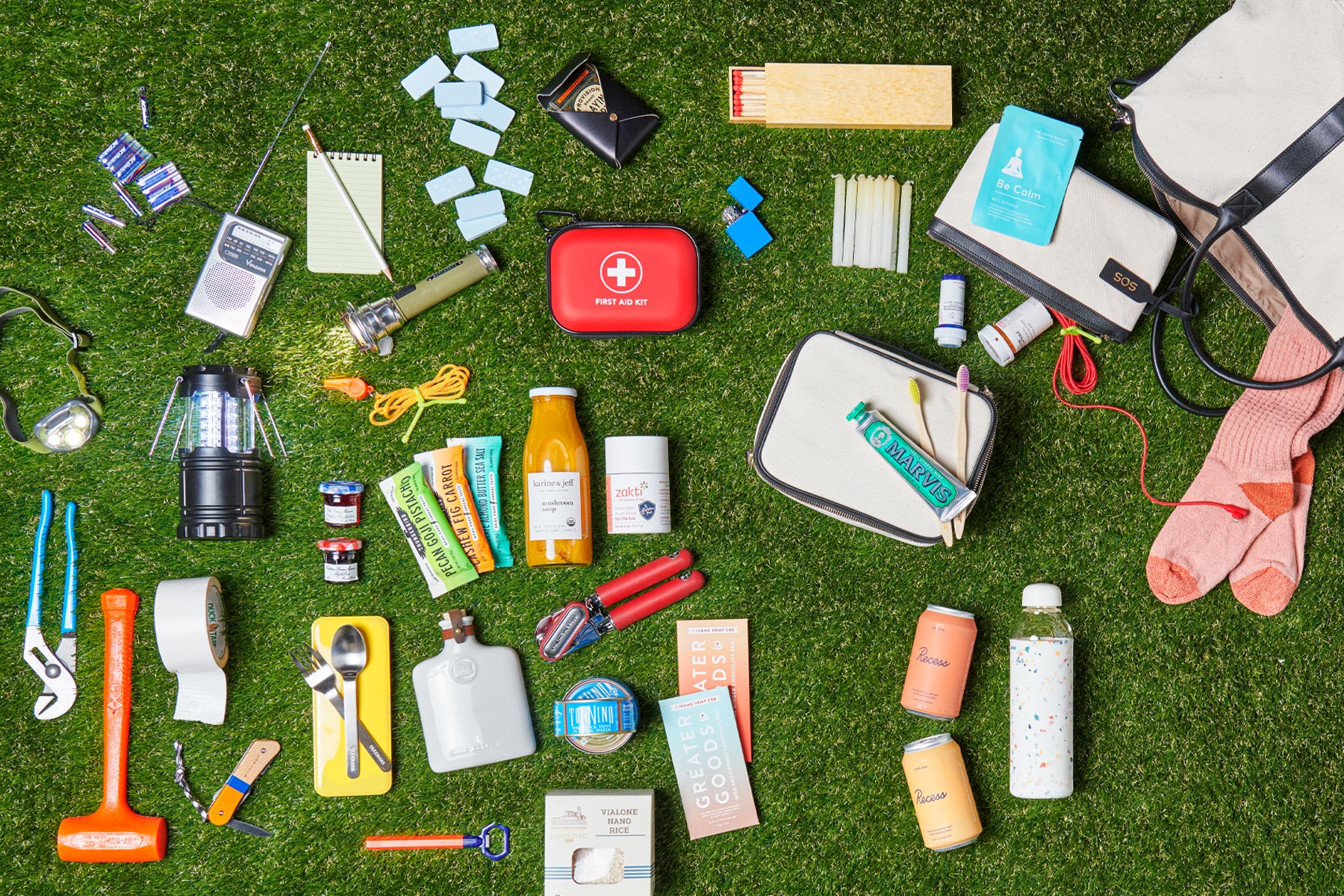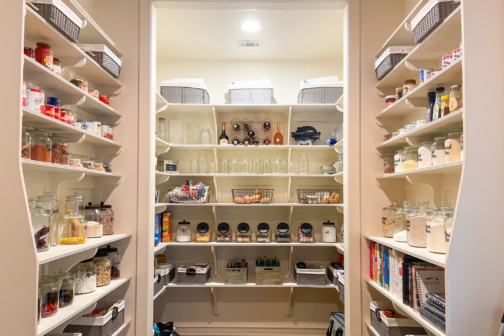Mother nature can be unpredictable and merciless. In just the past three years, Dallas has seen the costliest tornado outbreak in Texas history and the coldest temperature on record for the area since 1949, part of a winter storm that left thousands without power for days and countless homes damaged as a result of burst pipes and broken water heaters. Of course, disaster can strike at any moment—both of the natural and manmade varieties—so your best bet is to be ready. In this feature, those who have lived through the worst tell what they learned from their experiences and industry experts share home- and life-saving tips you can put into action now, so you’ll be ready for whatever comes your way.
How to Prepare for a Tornado
Ron and Gail Berlin, owners of Berlin Interests
Neighborhood: Preston Hollow
On October 20, 2019, as many Dallasites were watching the Cowboys crush the Eagles, an EF-3 tornado swept North Texas, hitting Preston Hollow particularly hard. The result: $1.5 billion in damages—the costliest tornado outbreak in Texas history.
With the wail of storm sirens blaring, Ron and Gail Berlin left the Cowboys game playing in their media room and made a mad dash for the basement. Two sets of solid walnut double doors flew backwards off their hinges, one smashing into a Frederick Morgan painting worth $192,000. A grandfather clock hurtled behind as they ran down the stairs to the wine cellar. They didn’t even have time to make it all the way to their concrete safe room; the tornado was gone in less than a minute.
Come daylight, Ron already had a crew of carpenters boarding up windows. Their son, who helps run the Berlins’ real estate development firm, brought heavy equipment and nine chainsaws from the family’s Oklahoma ranch to clear the roadway and remove trees from the site. Artwork and valuables were swiftly taken away to storage.

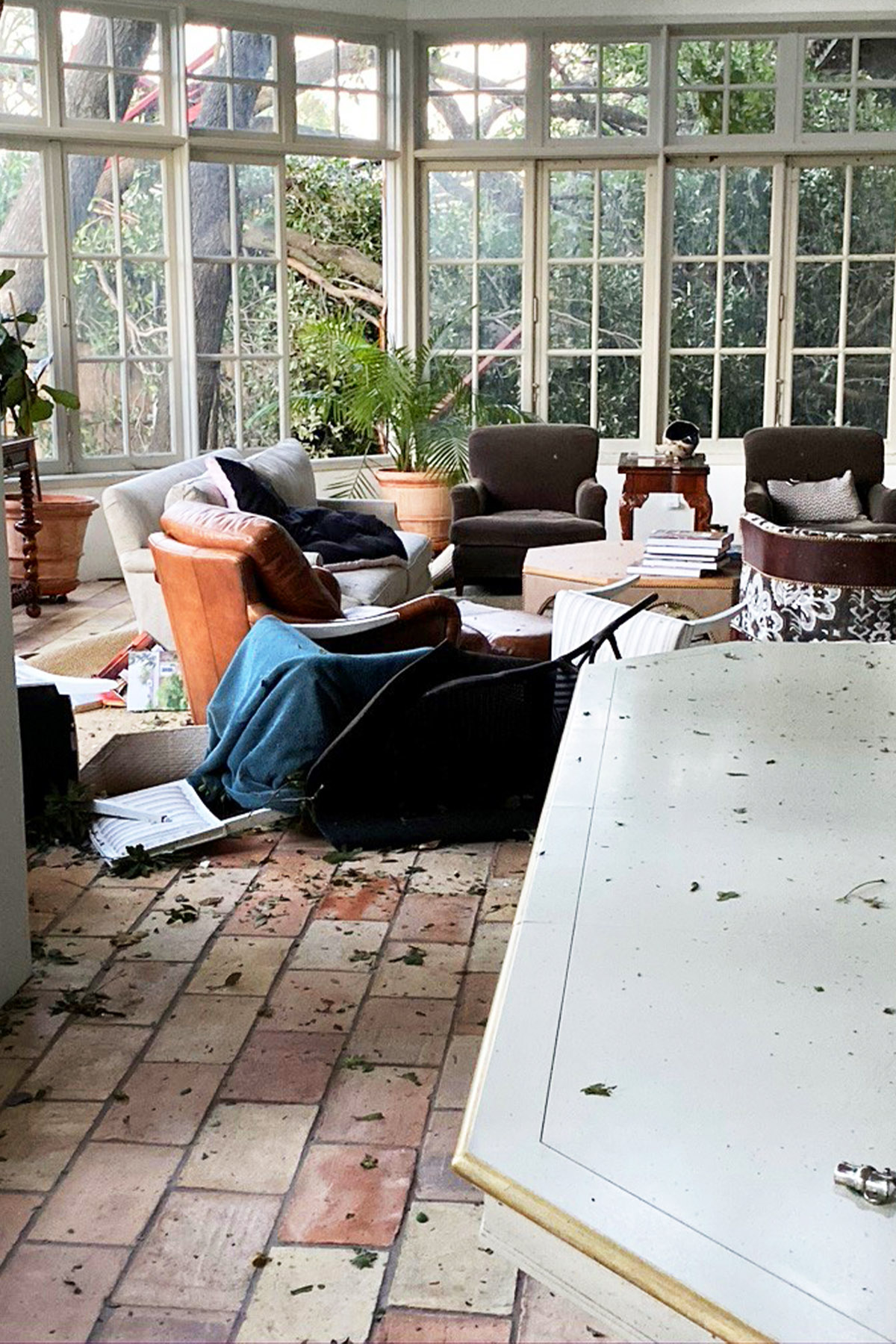
Though the Berlins’ 11,000-square-foot Preston Hollow home didn’t incur any major structural damage, they ended up with a total loss between $3 and $4 million. The roof alone, made of Ludowici terra cotta tiles, was a $750,000 claim (a company from Florida flew out to seal the damaged roof with a plastic shrink-wrap-like cover).
The timing stung. Their long-time designer, Denise McGaha, had just completed finishing touches on an arduous gut renovation a month prior.
But Ron believes the only way to get through a catastrophic event is to treat your beloved home like what it really is: an investment. He happily came to an agreement with Pure Insurance in just over two months, a quick process compared to many who were frozen by the trauma or who battled adjusters for months on end. “It is an emotional experience,” says Ron. “But you have to get over the emotion to get on with getting the claim handled immediately and doing anything to protect the asset that is remaining on the property.”
Don’t Forget Designers
“An interior designer is more than someone who just selects the furniture and the paint colors,” says Denise McGaha. “We’re helping a family rebuild their home—and I don’t take that lightly.” It’s a sentiment echoed by designer Cristie Schlosser, whose own home was devastated by the 2019 tornado. While Schlosser had her own restoration underway, she also helped several storm-stricken clients get their interiors back in shape “on a dime.” Schlosser recommends speaking with your insurance agent: If your home was previously designed by a pro, insurance may cover the service.
Peggy Levinson, design consultant
Neighborhood: North Dallas
At one point during the day after the storm, Peggy Levinson realized neighbors she had never met were clearing tree limbs from her yard and sweeping glass inside. Though the tornado destroyed houses, it brought the community together. “And then reality set in,” says Levinson, which was that the modern white stucco house she and husband Dana Fuller fell in love with a decade earlier was now unlivable. Worst of all: Of the 50 or so trees on her half-acre waterfront property, nearly 20 had to be hauled away. (Her insurance allowance for that work was depleted within two days.) It took 14 months to get the house back the way it was, though Peggy misses the natural shade canopy that once stood outside. But she is slowly replanting—several live oaks and a weeping willow at the water’s edge, thus far.
Replant Wisely
Seek out a professional tree service that will evaluate your land to plant appropriate trees in optimal spots, and most importantly, will guarantee the trees’ survival—most services will replace those that fail within a year.
Are You Covered?
Most insurance policies will cover damage caused by fallen trees, but many don’t cover the cost of replanting. If the value of your property hinges on your greenery, you can talk to an insurance broker or agent to get coverage over yard and garden.
WFAA Chief Meteorologist Pete Delkus Sounds Off:
“You always need to be weather ready, especially in Texas where things can change so quickly. It might be an app on your phone or an NOAA weather radio that goes off when a warning1 is issued for your zip code. We have something at my house called Weather Call. It’s 10 bucks a year. They’ll call my home phone or cell phone, text me, email me, you choose what you want, but you need some type of system to alert you to what’s going on in the middle of the night. People are like, ‘Well, I didn’t hear the storm sirens in my house.’ Well, those storm sirens are designed to alert people outside—not inside.”
Out on a Limb
Amy Langbein Heath, owner of Texas Tree Surgeons and ISA Board-Certified Master Arborist (BCMA) shares what to know about proper tree care before and after a storm.
DH: Who should homeowners call after a storm?
ALH: An arborist with an International Society of Arboriculture (ISA), TRAQ (Tree Risk Assessment Qualification), or a Board-Certified Master Arborist (BCMA), who can look at the likelihood a tree’s going fall [and] what it would hit. Properly cared for native trees should be able to withstand normal weather patterns. Very high winds can always bring a risk for limb breakage and total tree failure.
DH: Is annual trimming critical to storm survival?
ALH: Part of proper tree care is developing natural scaffolding. A tree that’s over-pruned and stripped out can’t absorb a wind front the way a tree with a more spreading and thoughtfully done scaffolding can. Really, trimming is less than more.
DH: So you don’t want tons of trimmed branches?
ALH: You want someone who’s going to explain why they’re making each cut. A company with experience right now is trimming way lower a percentage of the canopy, probably around 10 or 15 percent, because they know that after the storm last year, trees are stressed, and they need the extra nutrients that each leaf is making. If you do a heavy trim right now, it stresses the tree out even more, and it’s going to start this cycle of decline where the tree gets weak. If it doesn’t have nutrients, you’re going to get insects and diseases.
Amy Langbein Heath’s Top Tree Picks
- Bur Oak
- Pecan
- Cedar Elm
“Bur oaks do really well here because of their inherent shape and branch structure; they’re just more spread out.”
“Pecans are native and really like our soil type—it’s called the Blackland Prairie. They have wide-spreading roots, so they hold on well.”
“Cedar elm are really under-utilized in urban forest. We’re so densely populated and they have an up-and-down growth, so they do well between houses and in smaller backyards.”
Bruce Bernbaum, principal at Bernbaum/Magadini Architects, and Cindy Bernbaum, manager of Paper Affair
Neighborhood: North Dallas
Once the winds had died down, Bruce Bernbaum left his wife, Cindy, in the safety of the bathroom to survey the damage. The house was filled with debris and he couldn’t get out the front door—it was blocked by trees, roofing, and furniture from North Haven Gardens located across the street. “Am I getting new floors?” Cindy asked when Bruce returned. “I think you’re getting a new house,” he replied.
As the months of talks with contractors, engineers, and insurance wore on, the couple watched the cost of damages near the limits of their policy. They decided it would, in fact, be a wiser investment to put the money toward a rebuild—scraping the 2,300-square-foot 1954 structure and designing with a larger footprint, something more attractive to young families when they sell down the road.
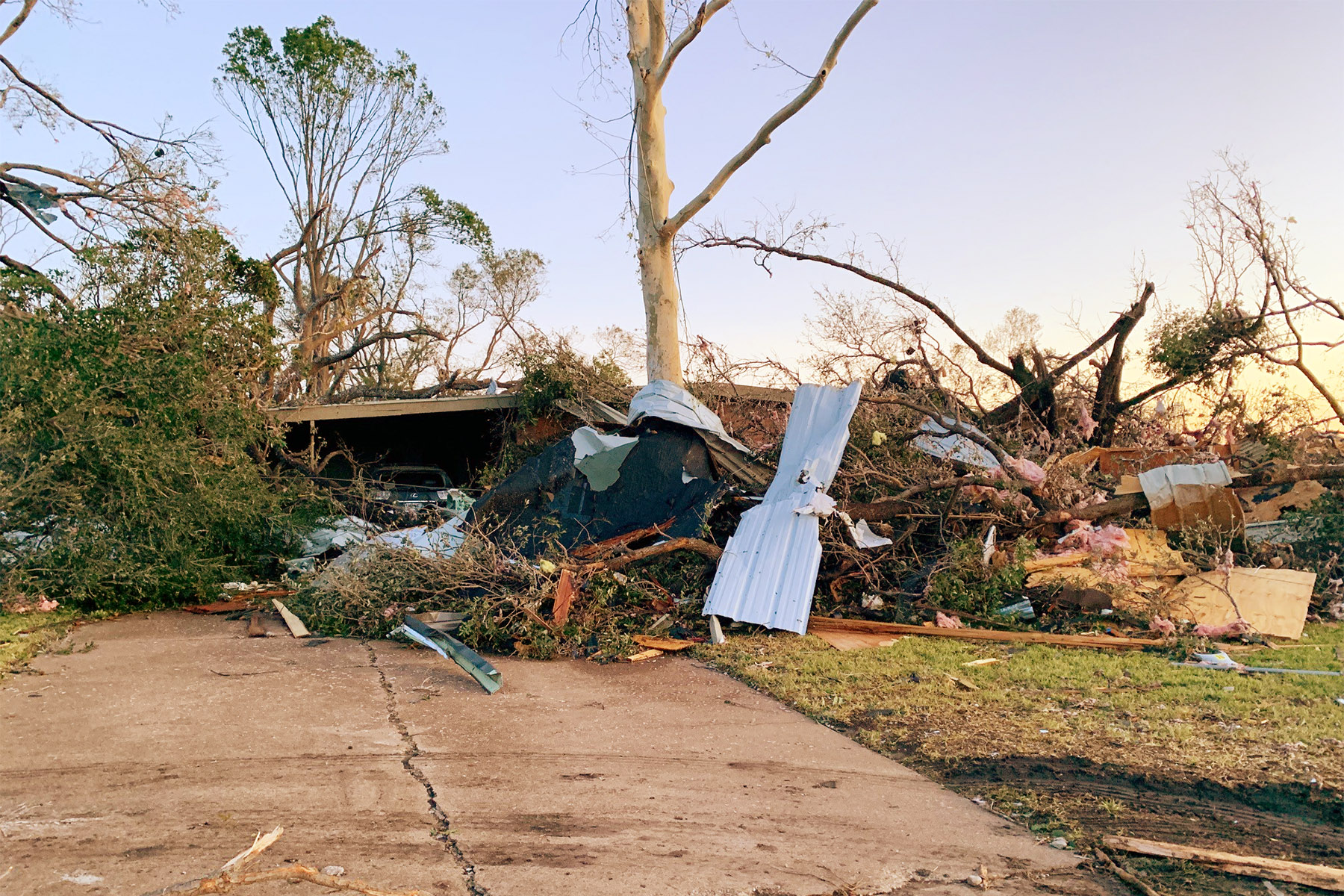
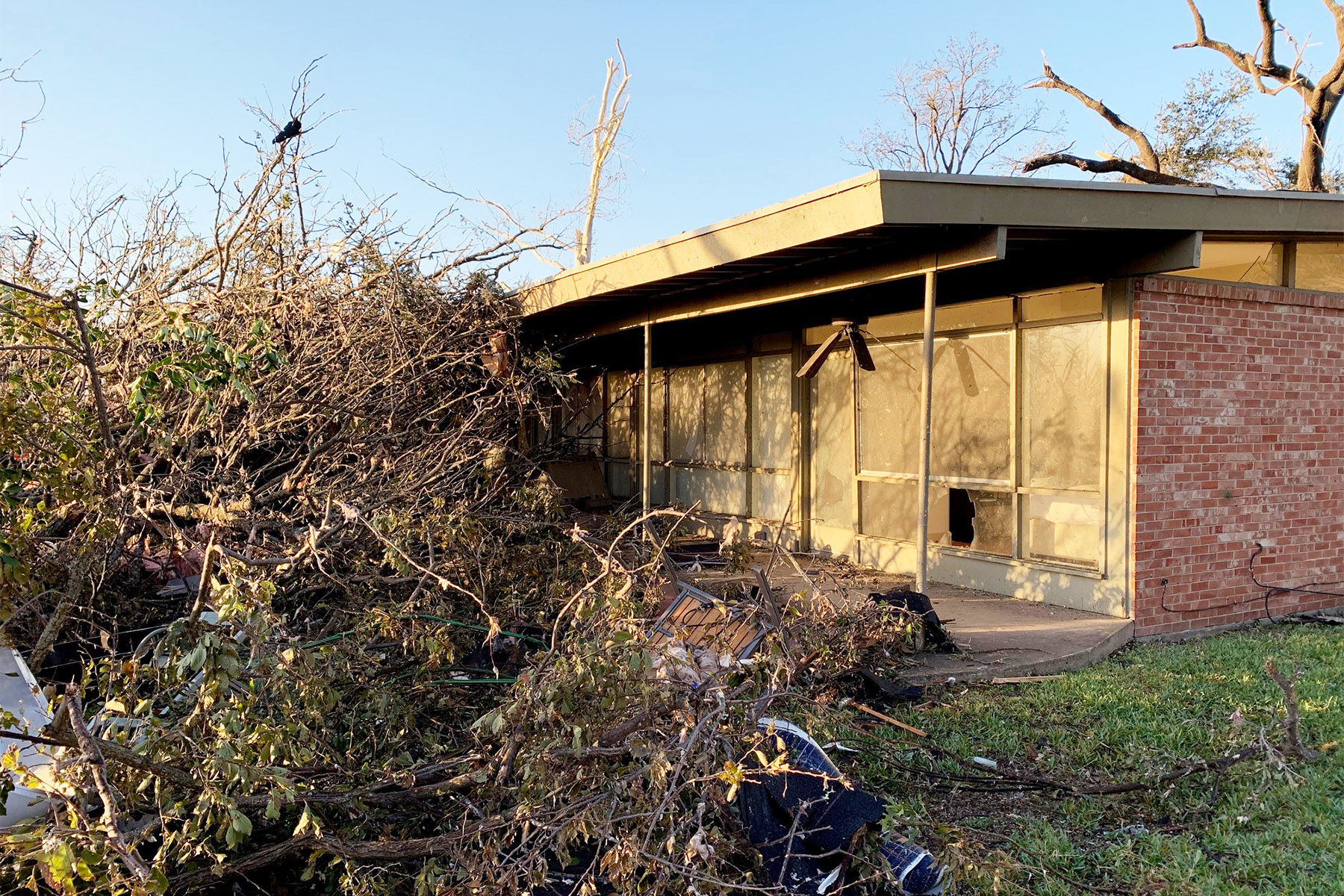
Bruce sat Cindy down as if she were a client and asked what she wanted in a new house. She gave him four answers: a powder room, a walk-in pantry, a utility room, and a pool. They also added 1,000 square feet and a large covered terrace—marketable entertainment space and room for their Thanksgiving morning Bloody Mary drink-a-thons. Bruce made one last-minute tweak to the plans, securing a walk-in closet to the slab and outfitting it with plywood and steel-plate walls and a storm-rated door, though he couldn’t imagine actually needing a safe room again.
Then, in May 2021, as the house was finally nearing completion, the unthinkable happened: A small tornado struck their house yet again, destroying the freshly erected fence and landscaping and dropping the neighbor’s new roof on their own. Fortunately, Bruce and Cindy had not yet moved in and the contractor’s insurance covered the damages. “Ninety-nine percent of the time you can’t plan for this,” Bruce says. “You can’t fathom what Mother Nature can do.”
Let’s Talk Safe Spaces
Of course, you’ll want to have a plan in place ahead of time to convene with your family members in the safest space your home has to offer. For most of us, that’s a window-less interior room on the lowest floor of the house—a closet, bathroom, or hallway—whatever puts the most walls between you and the outside. Want even greater protection? We examine a few of the sturdier options available.
- Basement
- Safe Rooms
- Concrete Homes
Why doesn’t our tornado-prone area have more sub-ground shelters? Don’t believe the slander involving hard clay. “It has nothing to do with the type of soil; it has more to do with the climate,” says Matt Cain, who has built a dozen or so basements as president of Tatum Brown Custom Homes. Up north, builders have to excavate below the frost line, so throwing in a basement doesn’t add much cost. Frost lines aren’t an issue here, so the earthwork to safely dig deep, waterproofing, and subgrade drainage to pump groundwater up into the sewer system all add up. Architect Joshua Nimmo—who designed the “floating” Glass House on Ricks Circle that cantilevers from a pseudo-basement (essentially a 5.5-foot “waterproofed crawl space”)—says he’s seen clients with $1 to $1.5 million budgets get basement quotes for an additional $250,000. “It’s not inexpensive to do it right in this region,” Nimmo says.
More cost-effective than a basement: Beefing up a laundry room or walk-in closet to perform double duty. John Hawkins of Hawkins-Welwood Homes did major remodels on 10 houses hit by the 2019 tornado; about half of those owners wanted safe rooms. That can entail, he explains, anything from plywood walls, double-bracing, and a steel door to the tune of around $2,500. The number moves up to engineer framing with tie-downs and up again for steel sheathing or poured-concrete rooms, costing $10,000 to $15,000. For existing homes, the most reasonable option may be calling a company such as Texas Storm Shelters, which offers custom or pre-fab shelters rated for an EF-5 tornado that can be installed anywhere, above ground or below. Prices start around $6,000 and go considerably higher depending on your needs. Says owner Stephen Cox, “You dream it, we can build it.”
Every now and then you’ll hear about a storm mowing down a neighborhood with the exception of one house. You can bet the lone survivor was made of concrete. In Dallas, Alan Hoffmann of Hoffmann Homes is the only builder working exclusively with the material, specifically ICF, or Insulated Concrete Forms. Hoffmann is blunt about his concrete-clad bias. “I’d rather build a house once. I don’t like twice,” he says. Though the cost of Hoffmann’s homes are about five to 10 percent higher than wood framing (maybe less considering today’s skyrocketing lumber prices), he claims the energy savings they provide “help pay for the safety.” Hoffmann builds concrete safe rooms following FEMA guidelines in all his spec houses, yet the entire structure is exceptionally sturdy: Studies show ICF walls, which include a six-inch thick concrete layer reinforced by steel, withstanding 200-mph winds.
Built to Last
The right choices when building can give your home a better chance at withstanding life’s storms.
- Frame it well: John Hawkins didn’t see any of his Hawkins-Welwood homes suffer structural damage as a result of the tornado. “We had a house, all we lost was a tree and a couple of windows. The guy across the street had a million dollars’ worth of damage,” Hawkins says. Why? Some of that had to do with luck; a lot of it had to do with good bones. Homes built in recent years have to adhere to stricter wood-framing guidelines. The better the skeleton, the better a home can take a storm.
- Get the right glass: For supreme storm-resistance, Alan Hoffmann has used Andersen triple-pane impact glass windows. The extra protection comes at a cost three to four times that of the norm.
- Choose a quality builder: “There’s a structural engineer involved in every project we build,” says Matt Cain of Tatum Brown Custom Homes. “A lot of what I would call more production-type builders don’t engage structural engineers because there’s so much repetition in what they build.”
How to Prepare for a Fire

Lari Gibbons, artist and professor, and David Radabaugh, editorial design director
Neighborhood: Denton
It was one of those spring thunderstorms familiar to any Texan, but Lari Gibbons knew in an instant that everything had changed. One minute she was catching up on emails with her rescue dog2, Blue, curled up at her feet. The next minute, Blue hit the bottom of her desk and smoke was billowing out of the air vents.
By the time Lari’s husband, David Radabaugh, arrived home, five fire engines were on the scene. The couple later received a lightning report (yes, every strike3 is counted and mapped) that registered two direct strikes hitting their Denton home, causing attic insulation to go up in flames and superheating wiring throughout the house.
David and Lari quickly learned that when it comes to destruction, fires are a triple-threat: What wasn’t destroyed by the fire itself was ruined by smoke or damaged by the firefighters’ efforts. In their case, first responders had to chainsaw a hole in the roof and chop open walls. The attic became so waterlogged that the ceiling eventually caved in.
After conditions were stabilized, Lari and David were allowed 10 minutes to gather prescriptions, car keys, and other necessities. “It was stupefying,” says Lari. “Everything was piled up in the middle of the rooms like a freight train went through.”
Three Quick Tips
Lari and David, who catalogued their restoration journey on Instagram (@blitzhaustx), share some of the lessons they learned along the way.
Keep Pet Carriers Out for Quick Exits
Lari did what you’re never supposed to do: After tying dog Blue to a tree, she went back in to save their two cats. All the animals had been to the vet the day prior, so fortuitously, the leash and carriers were still by the door. Lari recommends acclimating pets to carriers and keeping them accessible.
Store Flammable Chemicals Safely
Firefighters couldn’t believe how little damage Lari and David’s garage suffered—a tribute to Lari’s fastidious storage of flammable art supplies in fireproof containers. “Anyone who does home improvement projects and has cleaners, look at the labels,” David says. “You’d be surprised at how much is really flammable.”
Invest in Surge Protectors
“Nothing that was plugged into a surge protector was fried by the lightning, but everything that was plugged directly into the wall was destroyed,” David says. The small investment can protect pricey equipment and invaluable info.
Tip: Get one with a battery for your computer system so you have time to save work.
Face the Realities of Fire Restoration
A self-described clutter-phobe, Lari was surprised by how emotionally attached she felt to her belongings immediately after the fire. “But then I saw those storage fees rack up and how unsuccessful they were at restoring every single thing,” Lari says. Her advice: Only hold onto objects of nostalgic value.
Never Cook in a Kimono …
… and Other Hot Tips from Dallas’ Fire Prevention Lieutenant Anthony Jacobs
- Watch your pot: Unattended cooking is the number one cause of house fires. Keep an eye on anything frying, grilling, broiling, or boiling; and don’t leave home with anything in the oven. Also: turn pot handles inward, “not where they can be knocked over,” Jacobs says.
- Know how to handle grease fires: Water displaces grease, so dousing a grease fire will only cause it to overflow “and that will absolutely make it worse,” Jacobs says. Also note: Baking soda can squelch small fires, but flour is combustible. Your best bet is smothering flames with a pot lid or cookie sheet and turning off the stove. When all else fails: “ABC fire extinguishers do a good job of keeping small situations small,” Jacobs says.
- Wear fitted clothing while cooking: Robes and other loose garments can catch on pot handles or inadvertently ignite. Jacobs adds, “Those satin-like robes are often flammable.”
- Don’t hit snooze on electrical issues: Call an electrician to investigate shorts in your wiring, flickering lights, and outlets hot to the touch.
- Don’t use extension cords as permanent wiring—They can get overheated and burn. “If you’re going to have multiple items plugged into an area like behind your television, we suggest using power strips to give your internal breaker a break.”
- Call a chimney sweep before the cold season: “Everyone in Chicago knows that you need to have a chimney sweep check your chimney once a year,” says Jacobs, who stresses the importance of removing debris, obstructions, or nested animals. “But because we may only use our fireplaces for three days out of the year, we may not do that.”
- Don’t leave burning candles unattended: Snuff said.
- Only sleep in rooms made to be bedrooms: Jacobs suggests we imagine this scenario: a slumber party-turned-disaster when a fire traps kids in a window-less media room.
Fire Safety Supplies
- Fire Ladder
- Fire Blanket
- ABC Fire Extinguisher
- Nest
Slip under beds on the second story. Most fire ladders are single-use, but X-IT brand ladders are reusable, so you can (and should) do a practice run with it. X-IT 2-Story Fire Escape
Ladder, $100, Amazon.
Last June, Dallas music producer Jeff Saenz was electrocuted by downed power lines in his front yard. His partner, Monica Cooper, moved the lines away with a broom then covered his body with a fire blanket she got in the mail three days earlier. Saenz lost both hands, but those swift actions saved his life. Use code “MONICA20” when purchasing a Parcil blanket from their website to send a donation to his recovery.
Keep at least a couple in the house—the kitchen and garage workshops are good spots. And they don’t have to be eyesores. This metallic cylinder could pass as a Jeff Koons.
A low-profile Wi-Fi-connected option for the most crucial element of fire safety. Experts say it’s best to go with an interconnected model (hard-wired or wireless) so all alarms go off at once.
Nest Protect Smoke Alarm and Carbon Monoxide Detector, $119, Home Depot.
Create a Family Fire Plan
“The most important thing that any family can have is a working smoke detector; number two is a plan,” says Lieutenant Jacobs. But as he points out, a plan is only as good as the people who know about it. “Doing this job, I realized people had plans, but they don’t tell anyone—they think they have it all in their head. What we need is an organized plan that everyone in the family knows—and practices. There is no reason for an 8-year-old or 6-year-old to wait for a parent’s instructions. A home fire drill is a great time to find out that the bedroom window sticks a little bit, not when there’s a fire.”
Lieutenant Jacobs’ tips for creating a foolproof fire plan:
- Practice safe sleeping: Close your bedroom door at night—it acts as an extra barrier against fire. And be sure to have working smoke detectors in bedrooms and in the hallway outside, “so they will activate before smoke fills your room.”
- Map two routes out of your bedroom: Make sure everyone in the family knows the drill: Crawl to avoid smoke and feel the bedroom door for heat. “If it’s hot, there’s fire and you need to head to your secondary exit.” That will likely be your bedroom window, “even if that’s on a second story.” (See: Fire ladder.)
- Think about those who can’t help themselves: Figure out who’s going to help the baby, an elderly family member, or the furry friend. And if you have pets, run a realistic drill with the alarm sounded to witness their behavior. “How would they react? Do you need to search for them?”
- Agree on a meeting place: Whether it’s the big oak tree or the neighbor’s sidewalk, set a place for the family to gather, preferably out front to meet first responders. “It would be really sad to hear that you guys ran back in and your son is at the neighbors’ because you didn’t discuss that. This has absolutely happened.”
How to Prepare for a Freeze/Flood

John O’Connor, attorney, and Jenny O’Connor, photo stylist
Neighborhood: Lakewood
John O’Connor tuned into his Nest camera to see if the notification was true. Like five million other Texans, the O’Connor household lost power during the freeze in February 20214, and they decamped to warmer conditions. The good news: Power was, in fact, restored. The bad news: “It sounded like there was a waterfall in our house,” John says.
Both of the O’Connors’ tankless water heaters broke as a result of the freeze, one releasing cascades of water, and the outdoor drain-pipe meant to prevent such calamitous incidents was frozen shut. Since the water heaters were installed in the second story attic, water damaged nearly all the wood floors, as well as ceilings, walls, cabinetry, and furniture. The O’Connors’ 1921 Lakewood home, renovated only a few years earlier, would once again undergo a near-full reno.
John, who formerly worked with insurance companies as an attorney, had no qualms negotiating with USAA. The number they finally settled on was almost double his insurance adjuster’s first estimate. “A lot of it was doing things the right way versus a bare-minimum sort of approach,” John says.
Now that the house is back in order after four months of renovation work spearheaded by Peters-Cates Design, they’ve learned how to protect it if there’s a next time: Closing the water inlet valves to their water heaters during freezing blackouts.
Plumbing Aplomb
We all know the standard Dallas freeze drill:
- Disconnect hoses and wrap exterior faucets
- Open under-sink cabinets to allow in heat
- Drip faucets overnight
But when the city experiences freezing temps, plus power outages, “All bets are off,” says third-generation master plumber Phillip Cody, whose Cody & Sons Plumbing took 17,000 calls in February 2021. “Our guys were running nonstop, going home just to get five or six hours of sleep and they were back at it again the next day,” Cody says. “We did that for about a month straight.” Cody was startled by the damages. Dallas homes more than 7,500 square feet in size are required to have fire suppression systems; busted sprinklers turned some of the city’s grandest homes into total losses.
Cody’s advice for another snowpocalypse:
- If the power goes out: Since tankless water heaters’ built-in freeze-protection systems run off electricity, Cody recommends turning the unit off and bleeding the water out to prevent them from bursting. (Check with your water heater manufacturer or plumber ahead of time to have instructions handy).
- If you leave home during a freeze: Shut your home’s water off at the water meter (make sure you own a meter key or crescent wrench) then turn every faucet in your house to the “on” position to bleed the pipes. “That will allow any bits of water still trapped in there that are frozen to have room to expand without splitting your pipes,” Cody says.
- If you spring a leak:A water leak detector will shut off the home’s supply if it detects an abnormal water loss. Cody says installation can cost anywhere from $1,800 to $3,000, though cheaper DIY kits are popping up on the market. Your insurance may require a detector after a flood damage claim.
Power Up!
The sure-fire way to keep your house running without a hitch during blackouts is with a gas-fueled generator, which are currently hard to come by, thanks to supply-chain snafus on top of spiking demand (especially spiky with the influx of California expats accustomed to keeping generators). Homeowners are waiting four to six months for Cummins or Kohler units from Ryan Rendleman of Verdegy, Inc. For the average 2,000- to 3,500-square-foot house, he installs a 20kw generator, with turnkey prices starting at $10,000 to $13,000. The unit size and price goes up with each home’s square footage and power usage; add more for complicated installs. A sprawling estate could require a 3,500-pound generator at a cost between $50,000 to $100,000. “That’s by the time you wire it up, get it plumbed, pour a foundation, and rent a crane to set that heavy thing,” says Rendleman. “You’d be surprised how many homes in Dallas are so big they need generators the size of Suburbans.”
S. Holland Murphy, writer
Neighborhood: Eastwood
The morning of Dallas’ pandemic lockdown, my family woke up to a world turned upside down and a house turned inside out. A freak situation involving A/C plumbing and a torrential downpour the night prior left our house flooded, with a third needing to be gutted.
Insurance gave us money to replace wood floors on one side of our house. The contractor said she’d sand both old and new oak boards then stain them the same color. When I saw the finished job, I was confused. The new floors were darker with swishy lines, installed directly next to old floors—clearer but marked with lots of knots.
My contractor eventually brought in a specialist from French-Brown Floors. He explained that different trees have different markings, and those from 15 years ago certainly won’t look like today’s. You can’t match floorboards, and he wouldn’t have advised trying.
Our insurance company got away with skimping us. My contractor should have urged us to renegotiate. My husband and I should have known our rights as consumers, that we are entitled to “like kind and quality.” I had continuous floors pre-disaster. I should have continuous floors post-disaster.
I hired an appraiser to calculate the loss and argue my case to an umpire (essentially a mediator). Fifteen months after our flood, we were awarded a small sum; yet after paying the appraiser and umpire fees, we ended up with about a fourth of what we’d need for new floors. We don’t have the funds to pony up the remainder. For now, I guess, we’re just saving it for a rainy day.
Protecting Your Outdoor Space
How did the Dallas Arboretum hang onto its lush landscaping through freezemageddon while our yards were totaled? We asked VP of Gardens Dave Forehand for his tips.
- Hand Water
- Use Frost Cloth
- Year-Round Care
A day or two before the freeze, hand water so the roots get wet, but not the foliage. “With the moisture in the soil, it won’t get as cold as quickly. And when it gets cold and the roots are dry, it can cause more damage,” Forehand says.
Rolls are available at most hardware stores, “but if you have plenty of old sheets and blankets, that’s just as good,” Forehand says. Cover the entire plant and firmly secure with fabric pins or bricks. “We covered our vegetable and herb garden. When everything melted and we peeled back the cloth, we still had perfect lettuce.”
“A lot of the things we lost, they weren’t in as good of health,” Forehand says. The happier the plant, the better they can survive the stress of drastic climate conditions. That not only means proper maintenance, but also planting species that thrive on your particular patch of land (search: USDA Plant Hardiness Zone Map).
Forehand says these plants are “bulletproof” from big freezes:
- Aucubas: “They have waxy evergreen leaves and can grow well in deep shade.”
- Japanese Plum Yew: “Evergreen with dark green leaves, they can grow in deep shade.”
- Needle Palms: “These were unfazed by the big freeze. It is a large, clumping-form palm.”
- Holly Varieties: “All the Holly species were not harmed by the big freeze. Some good choices are Carissa Holly, which is a small compact plant that doesn’t need to be pruned. Another is a dwarf Burford holly, which can be shaped and maintained at about 4 to 8 feet in height.”
Pool Cues
Up in Massachusetts, where Adam Whitcomb of Liquidus Pools grew up, residents winterize their backyard lagoons (a process that includes draining half the water) but he has yet to perform that service in Texas. “There’s some days in the middle of the winter when it’s 70 degrees and people say, ‘I want to turn the heater on and jump in the pool,’” says Whitcomb. He explains that most pools have a freeze guard system that kicks on as temps dip, but that only works with electricity. About 75 percent of Liquidus clients had system failures due to the February power outage. If forecasts call for extended periods of below-freezing temperatures, potentially resulting in blackouts, Whitcomb suggests making sure all electricity is off to the system, then pulling the plugs on the pool pump and drain filter to remove water. “Once the freeze is over,” says Whitcomb, “we’ll come back and put it all together for you.”
TIP: Whitcomb says if extreme cold is in the forecast, tossing empty two-liter bottles in your pool will help absorb the expansion of ice sheets on the tile.
How to Prepare for a Break-in
Jamie Laubhan-Oliver, Editorial and Creative Director of D Home and Larry Oliver, Creative Director
Neighborhood: Winnetka Heights
The neat stack of mail was the first thing that struck Jamie Laubhan-Oliver as odd; the mail always scattered across the entryway when it went through the front door slot. Then she walked through the living room and realized the TV was gone, along with all electronics and jewelry, including the Hermès watch her husband, Larry, had just given her for Christmas. “They even ate my fruit,” Jamie says.
The police dusted for fingerprints to no avail. The Olivers realized the criminals made entry through the front gate (unlocked) to get into the shed (no lock) where they found everything necessary for a successful home invasion5: gloves and a crowbar used to wedge open a bathroom window (the Olivers rarely activated their security system).
The thieves were then able to make a swift getaway through a back gate (a padlock through the latch, but not actually locked). “I didn’t like the inconvenience of having to unlock the gate to take the trash out,” Jamie says. “But what’s more inconvenient is losing all your stuff.”
While the Olivers never caught the criminals, insurance covered the cost of stolen items—aside from the jewelry, which is often not included in home insurance policies. But the break-in took an emotional toll. “It’s an extreme violation,” Jamie says. “You don’t feel comfortable for a while.” Now, the Olivers take their home security seriously. “You have all these measures to not get broken into and you don’t use them. You just can’t be lazy when it comes to protecting your house.”
How to Not Get Robbed
We talked to Sr. Cpl. Brian Martinez of the Dallas Police Department to get some home protection tips.
- Don’t give burglars a good view: Point blinds upward so wannabe robbers can’t make a list of to-steal items by peering through your window.
- Maintain your landscape: Overgrown hedges provide cover for criminals attempting a break-in. Bonus: Your HOA will be delighted.
- Get a guard dog: Criminals tend to avoid canines. Rottweilers not required; even petite yappers will do. “It’s not about the size, its about the bark,” Martinez says.
- Get lit after dark: Crime is lower in heavily lit areas, so when it comes to outdoor property, “light it up like a Christmas tree,” Martinez says. (Sensor lights work great, too.)
- Make windows unbreakable: Invest in shatterproof windows. More reasonable: apply a thin laminate film to existing windows (available at most hardware stores).
- Keep cameras eye-level: Cameras mounted in high corners only prove movement; get a wide-lens doorbell camera for a better chance at capturing faces.
- Hidden safes are, well, safer: Don’t make it easy for thieves to find all your most-valuables and run. Install safes in closet walls, under beds, or as faux air vents.
How to Prepare for Any Disaster
What Should You Have on Hand?
Everyone should have a three-day Emergency Supply Kit at the ready. Here’s what to include, courtesy of the City of Dallas Office of Emergency Management:
- Water—one gallon of water per person per day for at least three days
- Food—at least a three-day supply of non-perishable food
- Radio—battery-powered or hand crank radio and a NOAA Weather Radio with tone alert and extra batteries for both
- Flashlight and extra batteries
- First-aid kit
- Whistle to signal for help
- Dust mask—to help filter contaminated air and plastic sheeting and duct tape to shelter-in-place
- Personal sanitation—Moist towelettes, garbage bags and plastic ties
- Wrench or pliers to turn off utilities
- Can opener for food (if kit contains canned food)
- Local maps
- Cash—in case ATMs are unavailable or something prevents the use of credit/debit cards
Don’t forget to include critical items for:
- Functional needs for family members—medications, special foods, medical equipment
- Infants—formula, diapers, bottles
- Pets—food, leash, medications
Pros to Know
- TakeStock Inventory: This Dallas-based company will catalog everything in your home and securely store photos, receipts, and certificates of authenticity—key in helping you recoup their value in an insurance claim.
- Delivery Limited: With a 155,000-square-foot, heavily secured storage facility, including a 5,000-square-foot art vault, Delivery Limited is the moving and storage company Dallas design pros have trusted for more than 40 years.
- Action Video Service: Don’t leave your priceless memories to chance. Action Video Service will digitize family photos and home movies so you can store them safely in the cloud and out of harm’s way.
Who’s Who in Insurance
Insurance Broker
Negotiates with different insurance companies to help you find the best plan for your needs.
Risk Manager
Essentially an insurance broker who tends to focus more on eliminating chances of risk, therefore delivering a more customized policy.
Insurance Agent
Your main point of contact once you sign the policy’s dotted line.
Insurance Adjuster
The insurance company rep who evaluates and puts a price on the amount of damage.
Public Adjuster
An independent insurance pro who can look over your policy and damage to help settle your claim. Usually works on a contingency. Should be licensed and able to offer references.
Appraiser
Independent insurance pro you hire if you and insurance can’t agree on a number. Will work with an independent appraiser hired by insurance to put a number on the amount of loss.
Insurance Lawyer
Point of legal recourse if you feel your claim isn’t being handled fairly. Often works on a contingency (usually higher than public adjusters).
Cover Your Bases
How you get through a disaster will largely be determined by one factor: your insurance policy. “Its not just having coverage, but having the appropriate coverage,” says Olivia Brosin of brokerage firm Swingle Collins & Associates. “It’s not one-size-fits-all, but something that needs to be tailored to the individual.” She shares a few policy pointers:
- Look at Your “Loss of Use”. While some insurance companies limit loss of use coverage to a specific dollar amount6, others offer unlimited coverage, “meaning they will put you up into a home of like kind and quality to your home” until your damaged abode is move-in ready, explains Brosin. “You want to be sure that your coverage will allow you to find temporary housing in a place that’s comparable to your house,” she says.
- You Got “Guaranteed Replacement Cost”? The cost of restoring or replacing your home can change dramatically due to inflation—especially if disaster strikes a large swathe of homeowners at the same time. If demand goes up, so does the cost of labor and materials. “A guaranteed replacement cost policy will extend beyond the limits if necessary to restore your home to its previous state after a loss,” says Brosin.
- Is Your Dwelling Amount Up to Snuff? Your dwelling amount will usually change over the years due to standard inflation, but Brosin encourages homeowners take a good look at that number and think: “Truly in this day and age, would you be able to build your home from the ground up with that dwelling limit?” In some cases, she explains, carriers will inspect clients’ homes to make sure they are covering all aspects of that home’s unique value.
Get the AtHome Newsletter
Author






